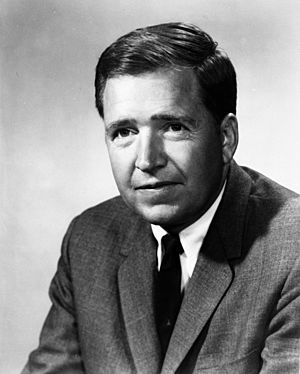Hoyt Patrick Taylor Jr. facts for kids
Quick facts for kids
Hoyt Patrick Taylor Jr.
|
|
|---|---|
 |
|
| 26th Lieutenant Governor of North Carolina | |
| In office January 3, 1969 – January 6, 1973 |
|
| Governor | Robert W. Scott |
| Preceded by | Robert W. Scott |
| Succeeded by | James B. Hunt Jr. |
| Speaker of the North Carolina House of Representatives | |
| In office 1965–1966 |
|
| Preceded by | H. Clifton Blue |
| Succeeded by | David M. Britt |
| Member of the North Carolina House of Representatives from Anson County |
|
| In office 1955–1967 |
|
| Preceded by | Hal W. Little |
| Succeeded by | District abolished |
| Personal details | |
| Born | April 1, 1924 Wadesboro, North Carolina |
| Died | April 22, 2018 (aged 94) Wadesboro, North Carolina |
| Political party | Democratic |
| Alma mater | University of North Carolina at Chapel Hill |
| Profession | Lawyer |
| Nickname | Pat |
| Military service | |
| Allegiance | United States of America |
| Battles/wars | World War II, Korean War. |
Hoyt Patrick "Pat" Taylor Jr. (born April 1, 1924 – died April 22, 2018) was an American politician and lawyer. He served as the leader of the North Carolina House of Representatives and later as the 26th Lieutenant Governor of North Carolina.
Contents
Early Life and Education
Pat Taylor was born in Wadesboro, North Carolina, on April 1, 1924. His father, Hoyt Patrick Taylor, also served as Lieutenant Governor of the state. They are the only father-son pair to have held this important office.
Pat Taylor studied at the University of North Carolina at Chapel Hill, earning both his undergraduate and law degrees. He served in the Marine Corps during both World War II and the Korean War. After his military service, he became a lawyer in Wadesboro.
Political Career Highlights
In 1955, Pat Taylor was elected to represent Anson County in the North Carolina House of Representatives. He served there until 1967. For his last two years, he held the powerful position of Speaker, meaning he was the leader of the House.
In May 1968, Taylor won the Democratic primary election for Lieutenant Governor. A primary election is how a political party chooses its candidate. He defeated Margaret Harper, who was the first woman to seek a major party's nomination for this role.
Taylor then won the main election in 1968, becoming Lieutenant Governor. He served from 1969 to 1973 alongside Governor Bob Scott. Taylor worked closely with Governor Scott to help pass new laws. They wanted to increase taxes, including on tobacco, to pay for better education and roads.
During this time, there were many protests about racial inequality. Taylor was against segregation and other unfair practices. He later spoke out even more strongly against racism.
Running for Governor
After his term as Lieutenant Governor, Pat Taylor decided to run for governor in 1972. Governor Scott could not run again due to state rules. Taylor's main opponents were Skipper Bowles, a wealthy businessman, and Wilbur Hobby, a labor union leader.
In the May 1972 primary, Taylor did not get as many votes as Bowles. The tax increases during his time as Lieutenant Governor had made him less popular. Also, Bowles used newer campaign methods, like focus groups and TV ads.
Taylor lost to Bowles in a second primary election, called a runoff. This was a tough race. Taylor had the support of Governor Scott's political group. Bowles gained support from other political groups and many black voters.
Pat Taylor also received a few votes for the Democratic Vice-Presidential nomination at the 1972 Democratic National Convention. This shows he was a respected figure in his party.
Political scientist Tom Eamon described Taylor in his 2014 book. He called Taylor a calm and reasonable politician. However, he noted that Taylor might not have always had a strong desire for political power.
Later Life and Legacy
After his defeat in 1972, Pat Taylor left elected politics. He went back to practicing law in Wadesboro. He also served on several different boards.
In 2005, Taylor wrote a book called Fourth Down & Goal to Go. In it, he shared stories about life and politics in Anson County and North Carolina.
Pat Taylor was married to Elizabeth Lockhart Taylor for over sixty years. They had three children and four grandchildren. He passed away on April 22, 2018, in Wadesboro, North Carolina, at the age of 94. He was a member of the Calvary Episcopal Church, a Rotarian, and a Freemason.
In 2010, the North Carolina General Assembly honored both Pat Taylor and his father with a special resolution. South Piedmont Community College named a center after him and his wife. Also, part of a local road now carries his name.


